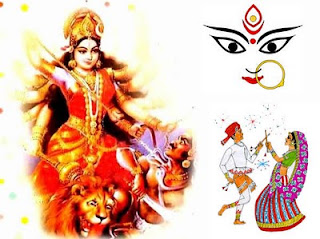|| Chaitra Navratri ||
Chaitra Navratri Is also called vasant Navratri or Ram Navratri, falls in the month of Chaitra each year. Is the festival of nine days dedicated to the nine forms of Shakti (Mother Goddess) in the spring season. Chaitra Navratri signifies the start of “VIKRAM SAMBAT” i.e the Hindu New Year. The 1st day is called a GUDI PADAWA which mainly celebrates in Maharastra. This is celebrated during Vasantha Ritu (beginning of summer).There for another names falls as a VASANT NAVRATRA and the 9ths day of Navratrs is the birth date of Shree Rama so this festival also called as a Ram Navratra. At the time of War between Shree Rama and Ravana, It was Lord Rama who worshipped Maa Durga for 9 days before going to war in Ashwina Month to invoke the blessing of Maa Durga and then the period got changed of Durga Puja from Chaitra to Ashwin. This is why the Durga Puja during (September – October) is also known as Akal Bodhon or untimely invocation.
King Dhruvasindu was killed by a lion when he went out hunting. Preparations were made to crown the prince Sudarsana. But, King Yudhajit of Ujjain, the father of Queen Lilavati, and King Virasena of Kalinga, the father of Queen Manorama, were each desirous of securing the Kosala throne for their respective grandsons. They fought with each other. King Virasena was killed in the battle. Manorama fled to the forest with Prince Sudarsana and a eunuch. They took refuge in the hermitage of Rishi Bharadwaja.
The victor, King Yudhajit, thereupon crowned his grandson, Satrujit, at Ayodhya, the capital of Kosala. He then went out in search of Manorama and her son. The Rishi said that he would not give up those who had soughts protection under him. Yudhajit became furious. He wanted to attack the Rishi. But, his minister told him about the truth of the Rishi’s statement. Yudhajit returned to his capital.
Fortune smiled on Prince Sudarsana. A hermit’s son came one day and called the eunuch by his Sanskrit name Kleeba. The prince caught the first syllable Kli and began to pronounce it as Kleem. This syllable happened to be a powerful, sacred Mantra. It is the Bija Akshara (root syllable) of the Divine Mother. The Prince obtained peace of mind and the Grace of the Divine Mother by the repeated utterance of this syllable. Devi appeared to him, blessed him and granted him divine weapons and an inexhaustible quiver.
The emissaries of the king of Benares passed through the Ashram of the Rishi and, when they saw the noble prince Sudarsana, they recommended him to Princess Sashikala, the daughter of the king of Benares.
The ceremony at which the princess was to choose her spouse was arranged. Sashikala at once chose Sudarsana. They were duly wedded. King Yudhajit, who had been present at the function, began to fight with the king of Benares. Devi helped Sudarsana and his father-in-law. Yudhajit mocked Her, upon which Devi promptly reduced Yudhajit and his army to ashes.
Thus Sudarsana, with his wife and his father-in-law, praised Devi. She was highly pleased and ordered them to perform Her worship with havan and other means during the Vasanta Navratri. Then She disappeared.Prince Sudarsana and Sashikala returned to the Ashram of Rishi Bharadwaja. The great Rishi blessed them and crowned Sudarsana as the king of Kosala. Sudarsana and Sashikala and the king of Benares implicitly carried out the commands of the Divine Mother and performed worship in a splendid manner during the Vasanta Navratri.Sudarsana’s descendants, namely, Sri Rama and Lakshmana, also performed worship of Devi during the Vasanta Navratri and were blessed with Her assistance in the recovery of Sita.
The fasting and feasting is part of the ritual of these nine days. Jagrans, Bhajan gatherings, temple visits are parts of the activities of devotees during navratri. It is the duty of the devout Hindus to worship the Devi (Mother Goddess) for both material and spiritual welfare during the Vasanta Navratri and follow the noble example set by Sudarsana and Sri Rama. He cannot achieve anything without the Divine Mother’s blessings. So, sing Her praise and repeat Her Mantra and Name. Meditate on Her form. Pray and obtain Her eternal Grace and blessings. May the Divine Mother bless you with all divine wealth!"
Related Article :
Navratri :
- Introduction
- Chaitra Navratri
- Sharad Navratri
- Puja and Ritual
- Vijayadashmi/Dashera
- Vijayadashmi Puja
- Nine Goddesses of Navratri
- Durga pooja Vidhi for Navaratri
Nine Form of Durga During Navratri :
- Shailputri Devi
- Bhramcharini Devi
- Chandraghanta Devi
- Kushmanda Devi
- Skandmata Devi
- Kaatyayani Devi
- Kaalratri Devi
- Mahagauri Devi
- Siddhiratri Devi
Share this article with your Network :


No comments:
Post a Comment